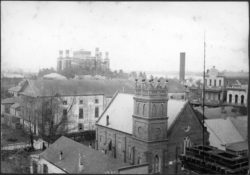Andrew Lytle
Based in Baton Rouge, early photographer Andrew Lytle spent a half-century chronicling the quotidian and exceptional events and faces of the city.

Courtesy of Louisiana State University Libraries, Special Collections
Baton Rouge: Aerial View. Lytle, Andrew (photographer)
Andrew Lytle began his photographic career when the medium was established but still offered great opportunity in terms of technical advancements and new markets for the services and products of professional photographers. Born in Ohio on April 4, 1834, Lytle was an itinerant photographer who was based in Cincinnati, Ohio, and worked throughout the mid-South. On the eve of the Civil War, Lytle settled in Baton Rouge, Louisiana, arriving in 1858. For the next half-century, he chronicled both the quotidian and exceptional events and faces of Louisiana’s capital city from his Main Street studio.
On May 9, 1862, Baton Rouge was occupied by the Union army. Lytle’s early work records both the character of the city and the faces of the soldiers stationed there. His view of the U.S.S. ironclad Choctaw at rest in the Mississippi River at Baton Rouge is a striking image of the new technology of naval warfare — a sliver of hull topped with an ungainly arrangement of iron slabs set at improbable angles. Another photograph, a group portrait of that ship’s crew, depicts dozens of men and boys, separated in age by decades and joined as a unit principally by the uniform they wear. Their faces reflect emotions ranging from bemusement to resignation, and maybe a little fear.
As his career progressed, and as Louisiana emerged from the fifteen years of Reconstruction, Lytle was joined in the business by his son Howard. In the late 1880s, the father-and-son business operated under the name of Lytle Studio. In addition to portraiture, the firm provided photographs for the Louisiana State Penitentiary, and also recorded the construction of levees in the area. The celebratory parades of Baton Rouge’s volunteer fire companies passed before the lenses of the Lytle Studio, perhaps due to the association of the Lytles with different organizations.
Though Andrew Lytle and the Lytle Studio were well known in Baton Rouge circles, recognition beyond this area was slow in coming. In 1911, with the publication of the ten-volume Photographic History of the Civil War by Francis T. Miller, Lytle’s work from half a century earlier reached a national public.
Lytle sold his negatives of the occupation of Baton Rouge to the publishers of this work. According to family accounts, the substantial remaining part of Lytle’s archive was destroyed by his daughter in the years following his death on June 8, 1917, in Baton Rouge. The Hill Memorial Library at Louisiana State University in Baton Rouge has a representative sample of glass negatives from Lytle and the Lytle Studio.
